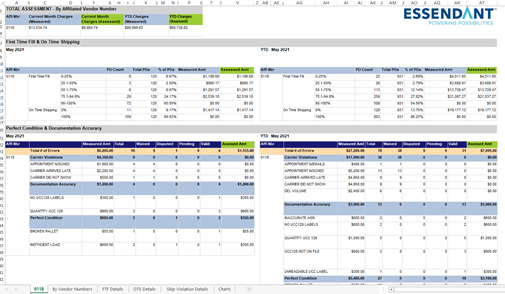Essendant fines by monthly Supplier Performance Assessment. The assessment is sent to compliance@advantus.com each month.
Disputes must be sent within 30 days, and before the next month’s Assessment is received.
- Compliance receives email notification of the violations for the previous month.

Essendant’s Supplier Scorecard
The Essendant Supplier Scorecard will contain an overview page of the Monthly charges and the categories that fines were assessed in: First Time Fill, On-Time Shipping, and Ship Violation Details. Each chargeback category will have a corresponding tab at the bottom of the Excel with the detail needed for the fine import template.

- Click on the appropriate tab for FTF (First Time Fill) or OTS (On Time Shipment) details.
- Filter the line detail to capture the Assessed Amount.

- Verify the violation is valid by entering the PO number in NetSuite and confirming ship date.
- If the fine is valid, record as appropriate.
- If the fine needs disputed, send to Harry Chernek at hchernek@advantus.com to dispute with the buyer at Essendant.
Researching OTS Fines
To determine if an OTS fine is valid:
- Navigate to the sales order in NetSuite by searching the PO.
- Find the first Customer Ship Date entry in System Information and check the date.
- NOTE: You must look at the FIRST Customer Ship Date in System Information when researching OTS fines. Do not refer to the Customer Ship Date at the top of the NetSuite page because that date is updated each time subsequent partial shipments are sent out.
- Find the date of our first shipment under this sales order. This can be found in the Items subtab by clicking View/Export IF Lines.
- If the first ship date is on or before the original Customer Ship Date, the OTS fine is invalid and should be disputed. The fine is valid and can be approved if the first ship date is after the original Customer Ship Date.
- If no problems have been identified, on the Sales Order page locate the carrier’s name and tracking number. Track the order and see if the carrier picked up or delivered the order late.
- The responsibility of a valid fine depends on where the delay that pushed the shipment past the original Customer Ship Date occurred, all dates can be found in System Information.
- Original Customer Ship Date is too close to the order date, responsibility = Customer Service.
- If Allocation took too long, responsibility = Supply Chain.
- If the order took too long to be released, responsibility = Order Management.
- If the pick order was created and the order wasn’t picked until much later, responsibility = Shipping-12th.
- If the completed order is not picked up in time, the responsibility may be the carrier’s.
Researching FTF Fines
To determine if a FTF fine is valid:
- Navigate to the sales order in NetSuite by searching the PO.
- Go to System information and make notes of the original Customer Ship Date, the dates the order passed Validation and Allocation, the date the order was released, the date the pick order was created and the date the order was picked, and the date the first shipment went out.
- Go to the Items subtab and click View/Export IF Lines. Compare the Shipped Date(s) to the original Customer Ship Date. If there are any subsequent partial shipments, the line will be highlighted in yellow.
- If there are yellow highlighted rows, we need to check to see if we notified Essendant the week prior that the item(s) was back-ordered.
- Open the Ess_Master_BO_List spreadsheet and check if there is a Y in the corresponding item’s row and the column before the week of the order date.
- If there is a Y, we notified Essendant early enough and the fine is invalid and should be disputed. If there is an N, the fine is valid.
- If the fine is valid it can be approved and responsibility = Supply Chain.
